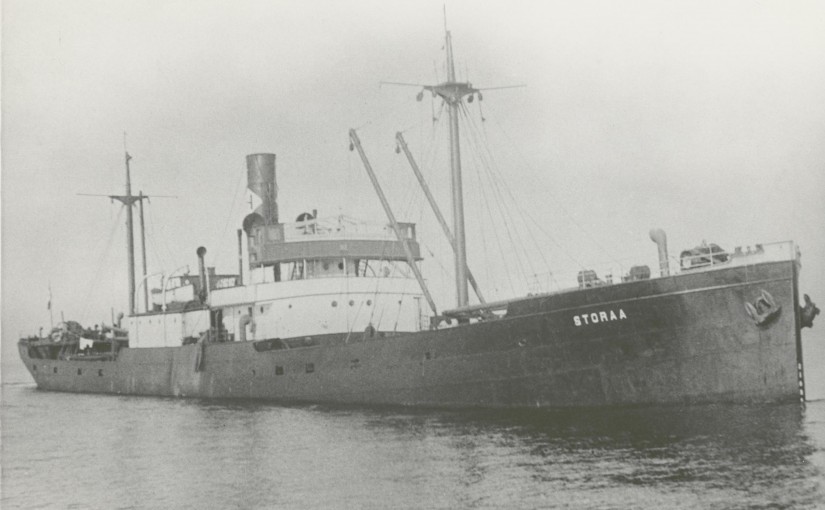The Ship that Woke Hastings
By Jenny Ridd
At 12.30 on the night of 3 November 1943, there was an almighty explosion about ten miles off the coast of Hastings. Convoy CW221 was sailing from the Thames to Cardiff laden with supplies for the D Day invasion when German E Boat S138 fired a torpedo. The starboard bow of the SS Storaa was badly holed and she sank bow-first within thirty seconds, taking with her the bodies of 21 men. Sixteen men survived, but the Captain, a hero named Jens Fage Pedersen, and the Dover Pilot, Watson Peverley were both among the casualties.
Storaa was built at Greenock in 1918, but eventually was owned by a Danish company. When Germany invaded Denmark in 1940, luckily Storaa was at sea, so she made for England and registered under the Red Ensign. In May she sailed under Captain Pedersen to Casablanca in Morocco, a French colony.
But then Germany invaded the Netherlands, Belgium and France, and by the time Storaa berthed at Casablanca on 13 June, the port was already under German control and she was captured. She was moved to Port Lyautey, 80 miles north on the Sebou River.
For two years Captain Pedersen and his crew were captives. Their clothing became rags, and he reported making shirts and shorts from his bedsheets. During this time several men escaped. Storaa’s First Mate, Mik Mikkelsen, slipped away on 14 September 1941 in a stolen boat, living on 8 bottles of claret and 12 tins of sardines. He rowed to Gibraltar, 160 miles away, and reached safety. Mikkelsen joined the British Special Operation Executive and was parachuted back to Denmark as an underground radio operator until he was eventually caught.
Part of the Allied invasion force under General Patton landed at Ft. Lyautey in November 1942 and SS Storaa was one of the first ships to be freed, despite having been ransacked and scuttled. Pedersen was ordered to raise her and get her ready to sail to Newcastle, as a prize of the British Ministry of War Transport.
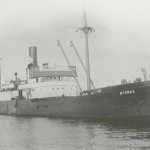
In 1943 the Allies were preparing for the invasion of Europe and tanks, aircraft, barges, guns and ammunition were being stockpiled. Storaa was loaded with supplies for a voyage from the Thames to Cardiff, through the English Channel. This was to be the final journey of the faithful old ship. Some 20 vessels sailed in the convoy, and she was one of three victims of an E Boat attack off Hastings.
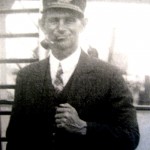
The Storaa was a very ordinary merchant ship and would have remained unknown but for a court case in 2003 that brought her to the public’s attention.
Whilst other members of the armed forces were given recognition for their heroic part in serving their country during the World Wars, tens of thousands of merchant seamen were never given that same respect. Yet without them, the war effort would have been impossible. After the war, the British Government began to sell off the wrecks for salvage, yet there was no provision for the remains of the dead who lay in these watery graves. Storaa’s hull was bought for scrap in 1985 for £150, although she was never salvaged.
Then in 1999 a gravel extraction scheme brought to light the knowledge that divers had been visiting the wreck site and carrying off souvenirs. Enter Dr. Peter Marsden, pre-eminent a maritime archaeologist, who founded the Shipwreck and Coastal Heritage Centre in Hastings. He felt that it was wrong that these graves could be disturbed like this, and applied to the Department of Media, Culture and Sport in 1999 to protect the wreck under the Protection of Wrecks Act. The MCMS turned down the application on the grounds that Storaa was not historically important.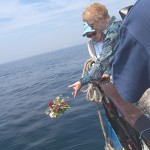
With the help of the Merchant Navy Association, who fully supported Peter’s application, he found the family of a Royal Navy gunner who had died on board the Storaa. Petty Officer James Varndell’s role had been to protect the ship and fire the guns, along with six other Royal Navy personnel. His daughters, Rosemary and Valerie, agreed to support a test case against the MOD and bring it to court, and courtesy of BBC South East News, they were taken by boat to the wreck site, where they cast flowers over their father’s grave.
A legal team came together who all offered their services free of charge, so strongly did they believe in the principle of the case. Everything hinged on whether the Storaa was considered to be “in military service” or not. In April 2005, Mr Justice Sullivan agreed to a Judicial Review, with the MOD paying all expenses.
As a result, the MOD came up with a lot of “reasons” as to why Storaa should not be protected. One was that Storaa’s gunners were deemed to be “passengers” and not crew – yet they were listed in the ship’s “List of Crew.”
Then the current owner of Storaa said that the team had found the wrong wreck, despite the latest High Definition Multibeam Sonar equipment having identified every aspect of Storaa. Also documents had been “weeded” during the 1960s, so statements about the military cargo could not be verified. However, a diving archaeologist visited Storaa on the seabed and photographed military equipment such as caterpillar tracks from tanks.
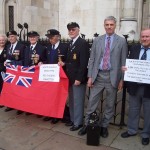
The wreck owner told the High Court that there were no human remains, yet the diving archaeologist found human leg bones. And so it went on. The MOD eventually lost their case in the High Court, but then took it to the Court of Appeal. On 17 October 2006, their Appeal was dismissed, and on 1 May 2008, Storaa was designated as a protected wreck.

After 60 years, merchant seamen had finally been given the respect they deserved. Peter Marsden and the legal team were delighted, as was the Merchant Navy Association, because a precedent is set for anyone to apply for protection for any merchant vessel wrecked off our coasts.
This could be potentially costly for the MOD, which is undoubtedly why they put up such a strong fight. And they are still continuing with their old tricks by not giving the locations of the protected ships. How can a “protected place” be protected if the position of the place is not published? Without that vital position anyone can salvage the wreck and claim that they did not know it was Storaa. So Storaa’s story may not be over yet, and another round may have to be fought in the courts before her last battle is won.
If you want to know more, Peter Marsden is giving a talk at SCHC on 20 June. Tickets in advance £8. Phone 01424 437452 for details.
“Hastings Town” June 2008
All articles, photographs, films and drawings on this web site are World Copyright Protected. No reproduction for publication without prior arrangement. (Hard Copy Back Numbers Still Available) © World Copyright 2015 Cinque Ports Magazines Rye Ltd., Guinea Hall Lodge Sellindge TN25 6EG
